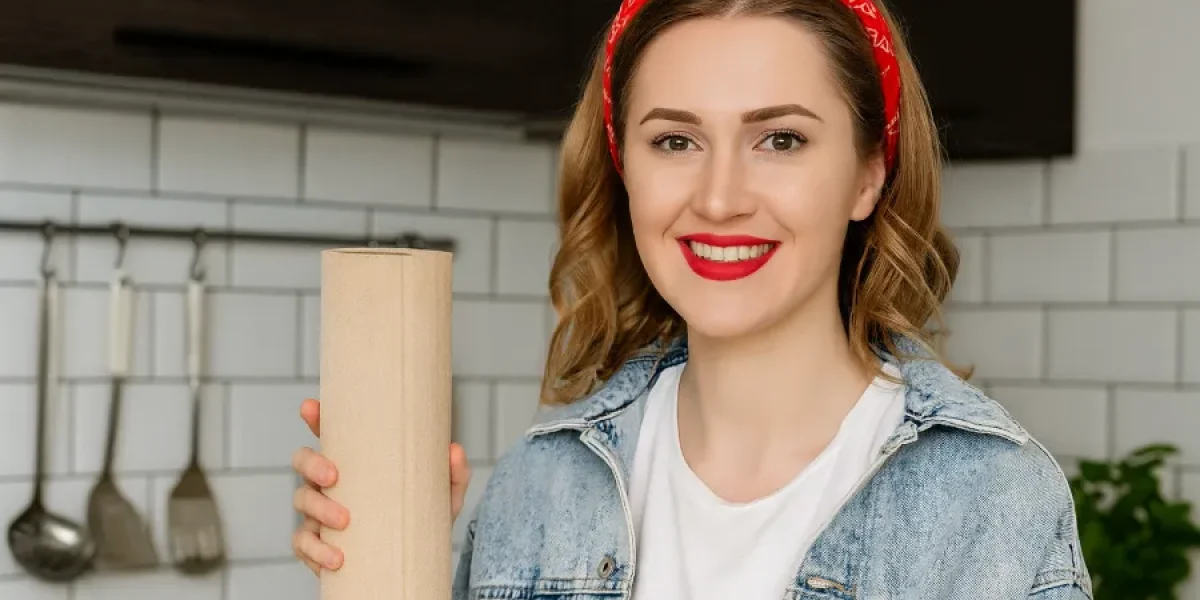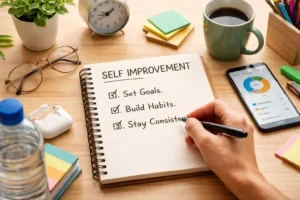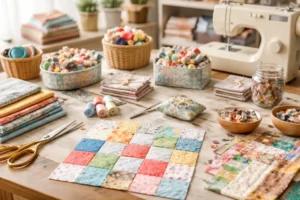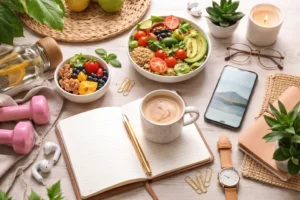
I’ve always loved the idea of having a zero-waste kitchen, but one of my toughest battles was paper towels. Tear, wipe, toss—it felt wasteful and waste piling up. Then I discovered bamboo towels as an eco-friendly replacement for paper towels in kitchen, and everything started to shift. Now, my counters are clean, my trash is lighter, and I feel like I’m doing something small but meaningful for the planet.
Over the past year, I’ve tried dozens of cloths, blends, and reusable options—and I want to share what’s stuck, what flopped, and how bamboo towels became the center of my kitchen routine. Below I’ll also cover how they fit alongside other trusted alternatives like Swedish dishcloths, terry cloth, microfiber cloths, unpaper towels, flour sack towels, reusable paper towels, and eco cloths. Think of this as your go-to roadmap for ditching disposables for good.
Eco-Friendly Towels: Why They Matter
Switching from single-use paper towels to eco-friendly towels isn’t just a trend. It’s a small daily habit with ripple effects. Every roll you skip is a tree saved, fewer chemicals in water systems, and less trash in landfills. For me, that’s worth the extra minute of washing cloths.
When choosing eco towels, I look for:
- durability
- absorbency
- ease of cleaning
- no lingering smells
- aesthetic that doesn’t feel like a chore
Bamboo towels check many of those boxes—so they became my anchor cloth.
Swedish Dishcloths
Swedish dishcloths are my “starter cloth” for folks new to reusable towels. Made from cellulose and cotton, these absorbent cloths are tiny but mighty.
What I love:
- They soak up 15–20× their weight in liquid.
- They’re quick to dry, so less mildew or odor.
- They’re compostable when they finally wear out.
I still use one or two for light spills and quick counter wipes. They complement bamboo towels well in daily use.
Terry Cloth
For messes that demand more muscle, terry cloth is my go-to. The looped cotton captures thick spills and greasy puddles without falling apart.
How I integrate it:
- I upcycle old towels—cut them into kitchen sizes and keep a stack.
- Use for draining pans, soaking up heavier spills, or scrubbing.
- Pair terry with bamboo: tackle tough messes with terry, then polish with bamboo or microfiber.
Terry doesn’t replace bamboo—it amplifies my cleaning toolkit.
Microfiber Cloths
When I want sparkle—on glass, stainless steel, or appliances—microfiber cloths step in. Their fine fibers trap dust and leave surfaces streak-free.
My caution: microfiber is plastic-derived. But because mine last many washes, I still view them as a more sustainable choice than paper towels. I just avoid fabric softeners (they ruin absorbency) and rotate them out for deep washing regularly.
Paper Towels

I used to buy paper towel bulk packs without thinking. They feel convenient—but they come at a cost.
- They’re designed to be thrown away after a single use.
- Their production demands trees, energy, and chemicals.
- Over time, the cost adds up.
Now, paper towels are strictly for backup—raw-meat spills or times when I forget to refill my cloths. Otherwise, bamboo towels and my cloth arsenal rule the day.
Unpaper Towels
Unpaper towels are one of my favorite “gateway cloths.” They’re cloth versions of paper towels—flannel or cotton squares, often snapped together to mimic a roll.
Why people like them:
- The format is familiar, reducing resistance in households.
- They’re washable and long-lasting.
- They come in fun prints, which helps feel like a choice, not a chore.
In my kitchen, I sometimes stack a few in a holder just to show off: “Yes, that’s a cloth roll, not a paper one.”
Flour Sack Towels
When delicacy matters—drying glasses, lining baskets, baking—I turn to flour sack towels. They’re thin, lint-free, and versatile.
They shine at:
- drying delicate glassware
- covering dough
- doubling as lightweight napkins
I always keep a dozen or so folded and ready, because they don’t hog drawer space but always deliver.
Reusable Paper Towels
“Reusable paper towels” sounds contradictory, but that’s the genius. These are cloth or bamboo sheets designed to feel like the paper towels we’re used to—often perforated or sized like conventional sheets.
They helped me shift mindsets:
- I could pull one off a roll, use it, and wash it—just like “real” towels.
- It bridged the gap for kitchen guests skeptical of full cloth swaps.
- Many high-quality options last dozens of wash cycles before wearing out.
They’re not perfect for all messes—but for everyday spills, they’re brilliant.
Bamboo Towels
Here’s where I land—in the loving arms of bamboo towels. If eco-friendly replacement for paper towels in kitchen is your goal, bamboo towels deserve center stage.
Why they became my kitchen MVP:
- Strong and absorbent: They outperform many cotton options.
- Naturally antimicrobial: Less stink, less bacteria.
- Reusable over many cycles: A single sheet may last 50–100 washes.
- Soft feel: Comfortable on hands, gentle on delicate surfaces.
When I use a bamboo towel, I feel like I’ve unlocked a “best of both worlds”—cloth durability with paper-like convenience. I use them daily: wiping counters, catching drips, cleaning surfaces, and more.
But bamboo is not perfect—sticky syrups or oil sometimes require backup cloths—but as my default, it’s unbeatable.
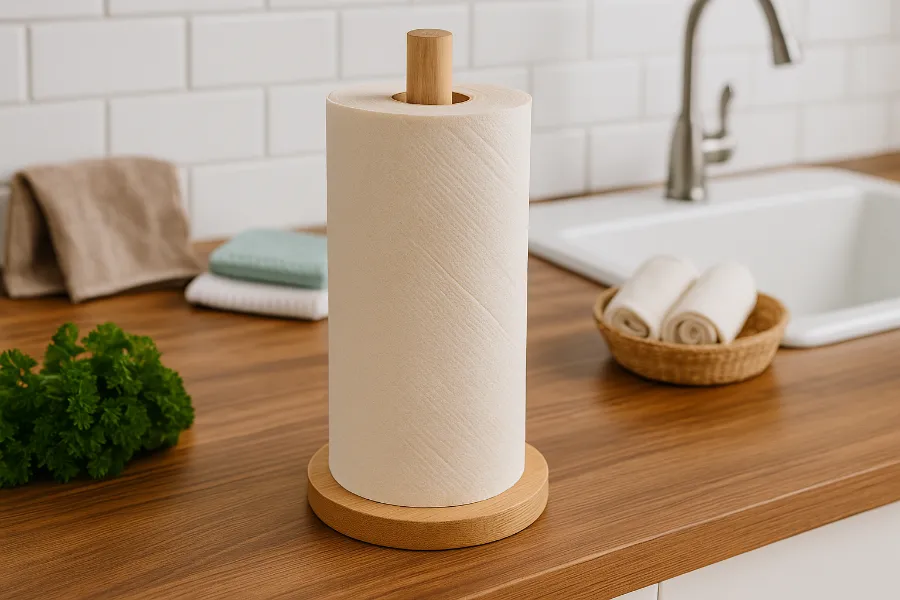
Eco Cloths
“Eco cloths” is my umbrella term for any cloth made from sustainable materials—
, hemp, bamboo blends—used for general-purpose cleaning.
In practice:
- I keep several textures: smooth, waffle, thicker weave.
- I color-code them to reduce cross-contamination (green for counters, blue for glass, etc.).
- They handle most daily tasks: wiping, dusting, polishing.
They’re also the ones I grab when I don’t want to think—just wash, dry, reuse.
Building Your Cloth System (How I Do It)
Transitioning from disposable to reusable doesn’t have to be dramatic. Here’s how I built mine (and you can too):
- Start with one bamboo roll or a few bamboo towels. Test them on everyday messes.
- Add complementary cloths (Swedish dishcloths, flour sack towels) for variety.
- Designate a clean/dirty system: a small basket by the sink, a hamper for used ones.
- Wash regularly: I aim for every 2–3 days. Use gentle detergent, no fabric softener.
- Dry fully—air dry or sun when possible to prevent mildew.
- Use backups as needed: keep old terry rags or microfiber for heavy jobs.
Over time, you’ll find your rhythm. I did. Now, using a cloth is second nature—and pulling a paper towel feels strange.
What Has Worked (and What Hasn’t) in My Cloth Journey
I’ve lived with this mix of cloths for months. Here’s what stuck—and what I’ve left behind:
- Swedish dishcloths were an early win: quick, low risk, easy to adopt.
- Terry cloth remains irreplaceable for messier jobs; it’s heavy-duty and dependable.
- Microfiber cloths are great for detail work, but residue builds up if not cleaned right.
- Unpaper towels are fun and effective “transitional” cloths I often show guests.
- Bamboo towels became my daily default—soft, strong, and “real cloth.”
- Flour sack towels are my kitchen workhorses when nothing fancier is needed.
- Eco cloths fill in all the gaps—they cover most tasks day to day.
What hasn’t worked: cloths that are too thin (they tear faster); chlorine-bleached blends; cloths that smell if left damp. But I tweak and rotate, and those issues fade.
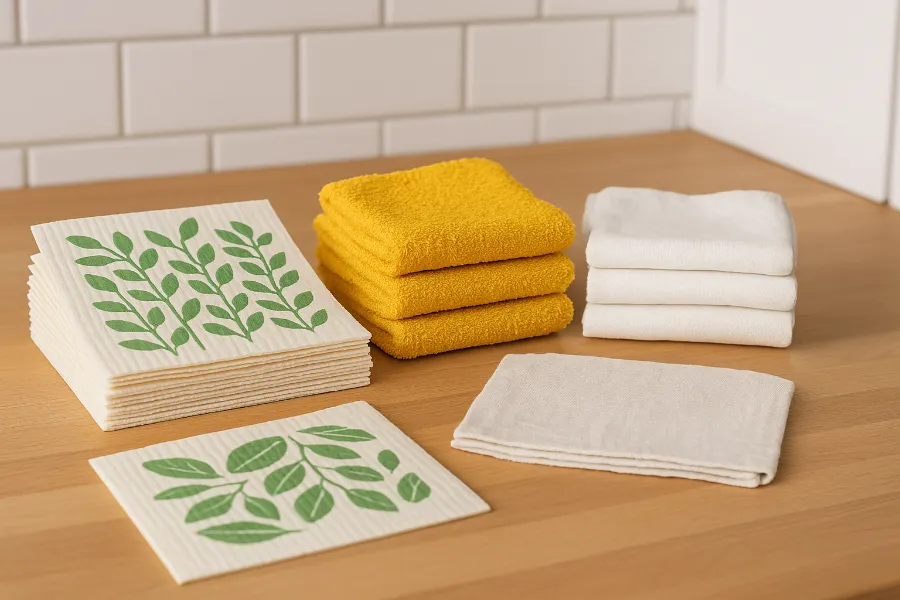
Final Thoughts: Why Bamboo Towels Could Be Your Next Best Swap
If I could tell you one thing: swapping in bamboo towels (with a supporting cast of cloths) is one of the easiest, most satisfying eco swaps you’ll make. They feel luxurious, clean well, and drastically reduce waste. Pair them with your trusted Swedish dishcloths, terry backups, microfiber for shine, unpaper towels for familiarity, and flour sack or eco cloths for versatility—and you’ll have a full cloth system that replaces nearly every roll in your kitchen.
I didn’t flip overnight. But each day I used one more cloth and one less sheet, I felt lighter—trash-wise and energy-wise. Give yourself time. Try a cloth or two. Build your set. And trust me: once you’ve cleaned with bamboo towels, you won’t miss the paper roll at all.

